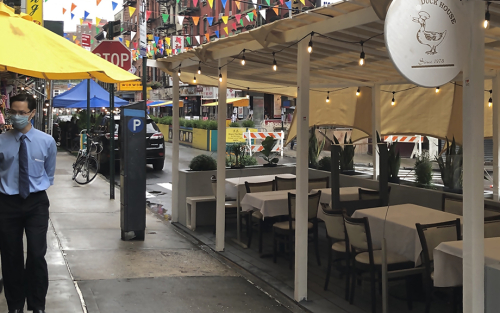The New York-Northern New Jersey region experienced an unprecedented downturn earlier this year, one more severe than that of the nation, and the region is still struggling to make up the ground that was lost. That is the key takeaway at an economic press briefing held today by the New York Fed examining economic conditions during the pandemic in the Federal Reserve’s Second District. Despite the substantial recovery so far, business activity, consumer spending, and employment are all still well below pre-pandemic levels in much of the region, and fiscal pressures are mounting for state and local governments. Importantly, job losses among lower-wage workers and people of color have been particularly consequential. The pace of recovery was already slowing in the region before the most recent surge in coronavirus cases, and we are now seeing signs of renewed weakening as we enter the winter.
Our region was hit extremely hard during the first wave of the pandemic, with New York City emerging as the epicenter. Businesses in the region saw an immediate and sharp plunge in economic activity, and many are still struggling to regain their footing. According to our regional business surveys, activity has yet to pick up significantly in the service sector, though the manufacturing sector has seen some modest growth since the spring. Consumers also pulled back strongly as the pandemic unfolded, though spending did recover to a large extent by the end of the summer as households received significant fiscal support. Unfortunately, the recovery has slowed, with business activity and consumer spending in our region flattening out.
Turning to the labor market, job losses during the depths of the pandemic were much more severe in the region than in the rest of the country, and remaining job shortfalls are quite a bit higher than nationally, particularly in New York City. As was true in much of the country, job losses were concentrated in the leisure and hospitality industry, though the retail and health sectors also experienced steep job losses. Only about half of the jobs that were lost in these key service sectors have been gained back in the region, and these gains were seen before the recent tightening of some government restrictions on businesses.
As a result, the effects of the pandemic have been uneven among workers in the region. Because the downturn caused such large job losses in leisure and hospitality and in retail, this shock has been particularly hard on lower-skilled workers and those who have little ability to work from home. Importantly, our analysis shows that lower-wage, less-educated workers were hit much harder than average, and people of color and younger workers are struggling to recoup job losses more so than other groups.
Despite ongoing weakness in the labor market, the housing market has held up. Home prices have continued to increase at a solid clip and in many places are rising at an even faster pace than before the pandemic. The notable exception to this trend is New York City, where home price growth was slowing before the pandemic, and where rents are currently falling. How long the weakness in New York City’s housing market will last is yet to be determined.
There are considerable downside risks to the near-term outlook. State and local governments throughout the region are under severe fiscal stress due to a combination of sizable revenue losses and increased demands for spending to fight the pandemic. These budgetary pressures are likely to persist for some time. Moreover, with the combination of renewed virus spread, tighter government restrictions on businesses, and colder weather now upon us, the region is clearly entering a challenging stretch, with heightened uncertainty facing businesses, households, and governments alike.
We will continue to monitor economic conditions in the region as the pandemic continues, and will provide timely updates as additional data and information become available. You can visit our Regional Economy website for more information useful in tracking the region’s economic performance during the pandemic.
 Jaison R. Abel is an assistant vice president in the Federal Reserve Bank of New York’s Research and Statistics Group.
Jaison R. Abel is an assistant vice president in the Federal Reserve Bank of New York’s Research and Statistics Group.
 Jason Bram is a research officer in the Bank’s Research and Statistics Group.
Jason Bram is a research officer in the Bank’s Research and Statistics Group.
 Richard Deitz is an assistant vice president in the Bank’s Research and Statistics Group.
Richard Deitz is an assistant vice president in the Bank’s Research and Statistics Group.
 Jonathan Hastings is a research associate in the Bank’s Research and Statistics Group.
Jonathan Hastings is a research associate in the Bank’s Research and Statistics Group.
How to cite this post:
Jaison R. Abel, Jason Bram, Richard Deitz, and Jonathan Hastings, “The Regional Economy during the Pandemic,” Federal Reserve Bank of New York Liberty Street Economics, December 2, 2020, https://libertystreeteconomics.newyorkfed.org/2020/12/the-regional-economy-during-the-pandemic.html.
Disclaimer
The views expressed in this post are those of the authors and do not necessarily reflect the position of the Federal Reserve Bank of New York or the Federal Reserve System. Any errors or omissions are the responsibility of the authors.











 RSS Feed
RSS Feed Follow Liberty Street Economics
Follow Liberty Street Economics